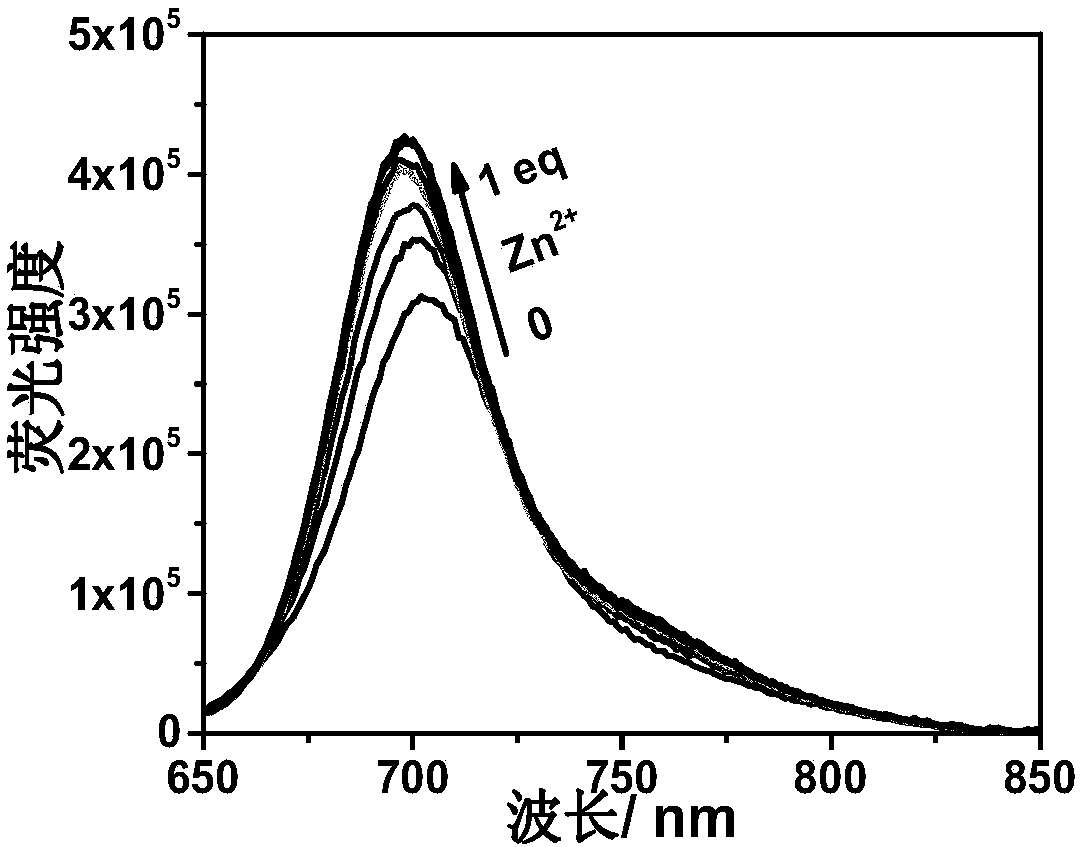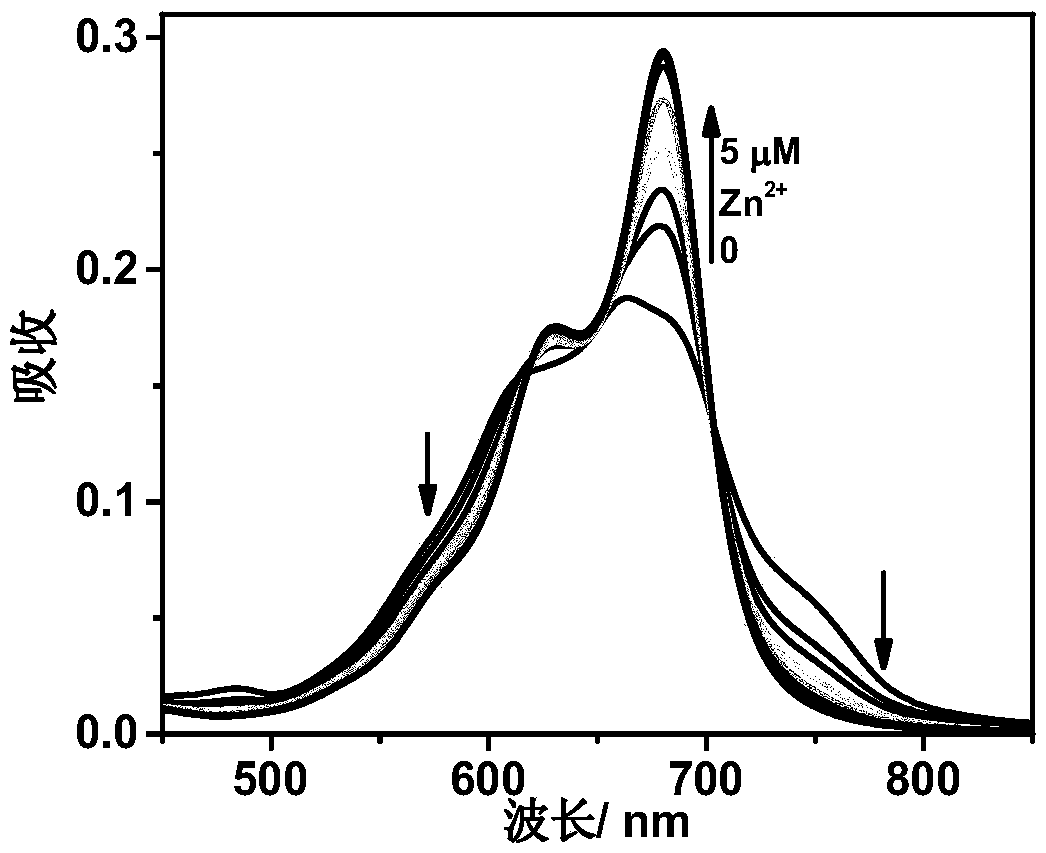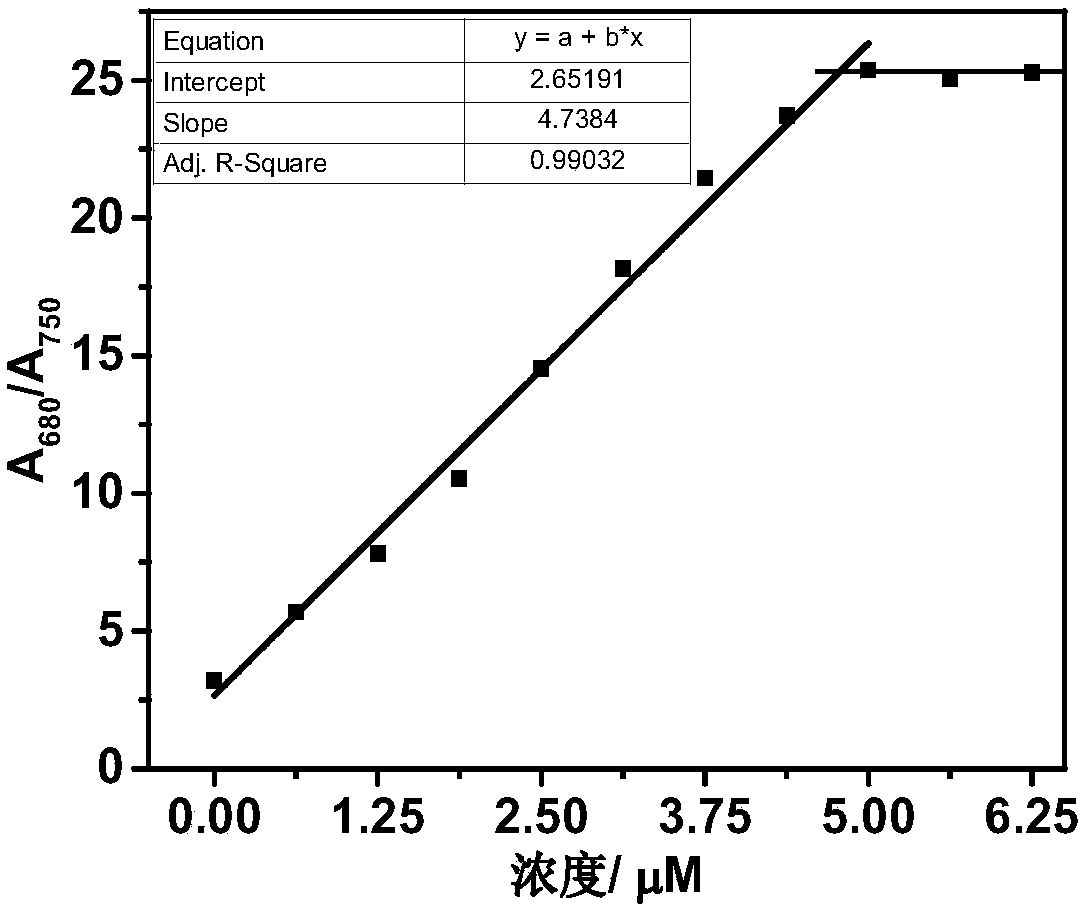Zinc ion proportion photoacoustic probes with mitochondrion-targeting function and application of probes
A proportional, anionic technology, applied in the field of biosensing, can solve problems such as increased memory and thinking skills, backward brain development and maturation, incomplete development of gender characteristics, etc., to achieve good biocompatibility, deep tissue penetration depth, Simple preparation method
- Summary
- Abstract
- Description
- Claims
- Application Information
AI Technical Summary
Problems solved by technology
Method used
Image
Examples
Embodiment 1
[0032] Embodiment 1: the preparation of compound 1
[0033]
[0034] 2, 4-dihydroxybenzaldehyde (10mmol), lutidine amine (10mmol) and sodium triacetoxyborohydride (20mmol) were dissolved in 100mL dichloroethane (DCE), ice bath and Ar atmosphere conditions After 24 hours of reaction, add 100mLNaHCO 3 Quench the reaction, extract 3 times with dichloromethane, use 50mL each time, collect the organic phase, Na 2 SO 4 Drying, spinning the solvent to obtain a yellow solid, carrying out column chromatography, methanol: dichloromethane (CH 2 Cl 2 )=50:1(v / v), after passing the crude product, use CH 2 Cl 2 Recrystallized with methanol, the final white product compound 1, yield: 31%. 1 H NMR (400 MHz, DMSO-d 6 )δ10.38(s,1H),9.13(s,1H),8.51(ddd,J=4.9,1.8,0.9Hz,2H),7.85–7.70(m, 2H),7.42(dt,J=7.9, 1.1Hz, 2H), 7.26(ddd, J=7.6, 4.8, 1.1Hz, 2H), 6.94(d, J=8.1Hz, 1H), 6.21(d, J=2.4Hz, 1H), 6.19-6.14( m,J=8.1Hz,1H),3.75(s,4H),3.57(s,2H). 13 C NMR (101 MHz, DMSO-d 6 )δ 159.00, 158....
Embodiment 2
[0035] Example 2: Preparation of photoacoustic probe HD-Zn
[0036] In a dry round bottom flask, add compound 1 (1 mmol), K 2 CO 3 (1mmol) and anhydrous DMF (3ml), the mixture was stirred at room temperature under nitrogen protection for 30min, and then the starting material compound 2 (0.5 mmol dissolved in 5ml anhydrous DMF) was injected by syringe. The reaction mixture was heated to 70° C. for 3 hours under nitrogen protection, the solvent was evaporated under reduced pressure, and the residue was subjected to silica gel column chromatography (CH 2 Cl 2 / methanol=50:1, v / v) separation to obtain the blue-green target product HD-Zn with a yield of 52.6%. 1 HNMR (400MHz, Methanol-d 4 )δ8.61(d, J=14.7Hz, 1H), 8.40(d, J=4.8Hz, 2H), 7.67(td, J=7.7, 1.7Hz, 2H), 7.55(d, J=7.3Hz, 1H),7.48–7.28(m,7H),7.19 (dd,J=7.4,5.0Hz,2H),6.78(s,1H),6.34(d,J=14.7Hz,1H),4.20(t,J =7.3Hz, 2H), 3.80(d, J =18.7Hz, 6H), 2.72-2.55(m, 2H), 1.83(t, J=7.1Hz, 4H), 1.71(s, 6H), 0.98(t ,J=7.3Hz, 3H). 1...
Embodiment 3
[0037] Embodiment 3: the emission spectrum test of HD-Zn
[0038] The spectral test concentration that the present invention adopts is 5 μ M, and test solvent is the HEPES solution (50 mM, 100 mM KNO) mixed with 1% DMSO 3 , pH7.4), when measuring the emission spectrum, the excitation wavelength is 633nm. Zn 2+ The solution is ZnCl 2 Soluble in water preparation.
[0039] The emission spectrum of HD-Zn is as figure 1 shown. When adding 1 equivalent of Zn 2+ After that, the fluorescence is enhanced by about 1 / 3 times, and the wavelength is also blue-shifted; it shows that the probe HD-Zn has a positive effect on Zn in the fluorescence spectrum. 2+ The response is not obvious.
[0040] Embodiment 3: Absorption spectrum test and detection limit calculation of HD-Zn
[0041] The absorption spectrum test concentration that the present invention adopts is 5 μ M, and test solvent is the HEPES solution (50mM, 50mM KNO) that is mixed with 1%DMSO 3 ,pH7.4), such as figure 2 As...
PUM
 Login to View More
Login to View More Abstract
Description
Claims
Application Information
 Login to View More
Login to View More - R&D
- Intellectual Property
- Life Sciences
- Materials
- Tech Scout
- Unparalleled Data Quality
- Higher Quality Content
- 60% Fewer Hallucinations
Browse by: Latest US Patents, China's latest patents, Technical Efficacy Thesaurus, Application Domain, Technology Topic, Popular Technical Reports.
© 2025 PatSnap. All rights reserved.Legal|Privacy policy|Modern Slavery Act Transparency Statement|Sitemap|About US| Contact US: help@patsnap.com



